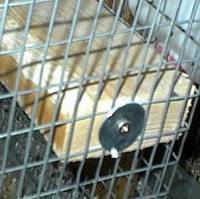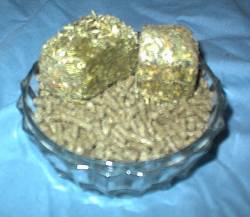|
|
|
 |
 |
|||||||||
| Home Page Colors- The Chinchilla Rainbow
|
Housing and Accessories Here is a pic of some of my cages. (I know, it's dark. I'll get a better one later.) I went through a lot of cages of various types. Finally, I've designed and built ones that I like.  Size (Length x Width x Height) In choosing a cage, size is very important. The smallest size cage for a single chin to live in is (in my opinion) 24"x18"x18" and for a pair of chins the smallest (in my opinion) is 24"x24"x18". The larger the cage however, the better and the more comfortable your chin(s) will be. With these minimum sizes, your chin will need lots of playtime outside of the cage and perhaps a wheel as well in order to get the right amount of exercise and prevent boredom. If a chin is kept in a small cage with nothing to do, he/she can become very stressed and start to chew on his/her own fur or a cage mate. He/she can also become obese. Having a large enough cage is imperative. Back to Top Materials Cages can be made of many different materials. Wire A wire cage should have wire spacing no larger than 1'x2' for an adult. If the cage is to be used for kits and breeding, the wire spacing should be no larger than 1/2"x1".I don't like to have wire flooring in my cages because it can hurt a chinchillas feet, but some people prefer it because it keeps the chinchillas out of the litter/bedding and prevents them from flinging it all over the surrounding area of the cage. If a cage does have wire flooring the spacing should be no larger than 1/2"x1" and some would argue that is too large. The drawbacks to having a wire cage are: a chin might cause itself injury by getting a leg stuck in the wire, the cage contents (bedding/litter and poo) are not contained and often end up all over the floor around the cage, and the cage can rust over time. Wood Cages can also be made of wood. It is preferable to use melamine or untreated pine. Pine however can absorb urine and odors. Melamine is more expensive and the cage builder must be sure not to leave any exposed edges for the chinchillas to chew on. The drawback to any solid cage is the lack of air circulation, but this can be remedied with windows, air holes, and combining the cage with wire. Other Others have made their cages out of materials such as glass, old metal filing cabinets (with drawers removed and a wire front put on) and large bird cages (made of bars). Other Considerations Do not buy a cage made of plastic or coated wire. Chinchillas can (and in most cases will) chew through this. Back to Top Multi-Level Cages Multi-level cages are great because chinchillas love to jump. Levels can be full, half, or more like a shelf. They can be made of wood or wire, though in most cases wood is preferable because it is not only easier on their feet, but it also provides them with something to chew on. A single level cage can be made into a multi-level one by adding shelves and perches as discussed below. When adding levels or buying a multi-level cage, it is best to tier them so that if a chin falls (especially young ones) he/she won't have very far to fall, reducing the risk of injury.  This is a 24"x18"x36" cage. It has three levels: the main floor, a half level, and full level on top. Back to Top Shelves and Perches Chinchillas love to jump and being in high places makes them feel safe. You can easily add shelves to a wire cage by cutting a 2x4 or 2x6 board to the apropriate length and using large washers and 1 1/4" screws. For a solid cage, you can simply use screws. The board should be made of untreated pine and be replaced as needed. Your chin will chew on it, so watch to make sure that they do not chew down to the screws (though I have never had this happen, it's possible). Perches can be attatched in the same manner.  This is how I attach shelves to my wire cages. Three screw/washer sets are needed: one on each end and one in the middle (to keep the chin from getting his/her leg stuck between the board and cage). Back to TopWheels Many chinchillas love to have a wheel in their cage to run on. Wheels should be at least 14" in diameter (though with small chins 12" might be okay). Many people prefer solid wheels to wire ones due to the risk of injury by a wire wheel. You can make your own wheel out of a lazy susan kit and a feed pan or by following the instruction on the ChinMania Site. A number of different types of wheels can be purchased at Chinworld.  Here is Beauty on a solid wheel. Back to TopSleeping Box Your chin should have a place to go where he/she can hide and be alone. This can be anything from a nice wooden house, a ceramic house, a large coffee can, or a temporary cardboard house (made of ink-free, clean cardboard). These can be homemade or store bought. Back to Top Food Dish and Water Bottles A food dish should be metal, glass, or ceramic. Plastic will be chewed. I bought all of my dishes at the dollar store and second hand stores. They don't need to be anything fancy (though they can be). A heavy, wide and somewhat shallow dish or one that attaches to the side of the cage is preferred because they do not tip easily. A water bottle does not need to be large. Eight ounce bottles work great as chinchillas do not drink a lot of water and water needs to be changed daily anyway to prevent bacteria growth. I prefer glass bottles because plastic ones can be chewed. When they get a hole in them they will leak, getting the cage all wet. A metal guard can be purchased to protect a plastic bottle, but as my chins have proven, even these are not destructable.   Here is an example of a good food dish and a picture of the water bottles I use. Back to Top Litter Pans Some chinchillas can be taught to pee in a litter pan. They will still poo everywhere, but will pee in the pan/box, which can easily be changed daily. For my chinchillas, I have used small, square, metal cake pans that I bought at the dollar store. These worked great, but they eventually rusted. Glass or ceramic litter boxes are preffered. To start, you simply place some soiled litter along with some clean litter in the pan and put it in the spot where your chin pees most often (usually a corner). Soon your chin will not need you to put any soiled litter in the pan. Your chin will simply pee there. Back to Top Bedding and Litter NEVER USE CEDAR in your chins cage. Cedar can cause respiratory problems and should not be used for any small animals. Acceptable bedding/litter includes kiln dried pine, newspaper (this gets smelly and soggy), Carefresh (or similar products), aspen, and pine wood stove pellets. In my cages, I use kiln dried pine and aspen in my cages. Back to Top Dust Bath Your chin requires a dust bath at least twice a week, more in humid climates, or as desired. A dust bath removes the oils from the chinchillas fur and helps the coat stay soft. All you have to do is place some chinchilla dust in a bath container, put it in the chinchillas cage for 5-15 minutes, and watch. For a bath container, you can use anything from a pan, glass bowl, large glass jar, manufactured chinchilla bath house, or a number of other things. Back to Top Diet Pellets In choosing what type of pellets to feed your chin, you must consider the following:
I recommend getting the opinions of other chin owners in your area concerning the types of pellets and where to buy them. Always check the date on pellets. Chin pellets are only good for about 3 months. Some newer diets are designed to last as long as 6 months, but it is better to be safe. Pellets often sit on the shelf for months before you buy them so be sure to check the date even if you have bought from that store before. Some good chin diets are Mazuri, Tradition, American Pet Diner, Oxbow, Kline and very high quality rabbit pellets. I buy large bags of Purina Advanced Nutrition Show Formula Rabbit Pellets from a local feed store. You may wish to purchase your pellets on-line if there are no good suppliers in your area.  Here are some hay cubes and pellets. I free feed my chins, so I fill the dish to the top. Back to Top Hay Your chin should always have some hay. You can either feed loose hay or cubed hay. If you feed loose hay, don't give your chin more than he/she can eat at one time as it will lay on the bottm of the cage. If it gets wet (by urine or a leaky water bottle) and your chin eats it, he/she can become very ill, not to mention the hay is wasted. Be sure to give your chin enough hay, however, so that he/she gets the roughage necessary to remain healthy. A hand full or two of hay per day is usually enough. Make sure the hay or hay cubes that you purchase are dry, fresh, and free of bugs. Hay that is really dusty is not good. If you feed an alfalfa based pellet, it is best to feed timothy hay or a mix of timaothy and alfalfa hay. If you know someone with horses, perhaps they can help you in selecting quality hay or even supply you with some. Back to Top Treats You can give your chin one small treats a day, but not too many as it can make them sick. My chins have tried the following treats and liked them:
DO NOT give your chin a lot of sugary foods (like fruits). Be careful when feeding store bought dried fruits as they usually have added sugar and/or preservatives. I prefer to dry my own fruits and veggies. |
|||||||||